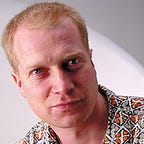Some Important Energy Centers
Today I would like to offer you to gain insight into some important energy center or acupuncture points that we are using in Qigong practice. Don´t panic, I will cover merely some points, you are not going to learn those 365 points or even 72 of the major points, but only four places with points to begin with.
For the Qigong practice we basically need points to ingest Qi from our surrounding, points to release Qi, points to lead and direct Qi, center to store and condense Qi. Let´s try to find these points…
We start with the points we use to direct and lead the Qi. Their Chinese name is Lao Gong or “Heart-Gate” or “Palace of Toil”. It is a point on the Pericardium Meridian (Pe 8) and it is located in the middle of the palm or under the tip off your middle finger if you curl it inwards until it touches the palm. Don´t worry, you don´t need to identify the exact location of the point, because we don´t use it for acupuncture. (see picture) To address an area with a diameter of round about 2 cm is precise enough. With these two points (one in each palm) we are guiding, collecting and lead the Qi, besides using our visualization of where the Qi should move to. Also we use them to give Qi-Treatments. (You may imagine a torch-light in each palm and the Qi coming out of the palms like a beam of light.)
The next points I like to cover are two points I already mentioned in a prior story. The points are located in each sole of the feet quasi similar to the Lao Gong points in our palms. Now I assume that you probably are not able to curl in your middle toes until their tips are touching the soles of your feet. But if you could do so, you would find the area of these energy points, which are called Yong Quan or “Gushing Spring”. They are the beginning points of the Kidney Meridians and also they are the lowest acupuncture points on the body (the only recognized points on the soles of the feet). The Point is located in the middle of the sole. If you project your second toe for one third of the sole, between the middle bones of the second toe and the middle toe, you find the point. (see picture) Also think of an area of 2 cm in diameter. Through these points we are emitting or getting rid of old energies. (Imagine a bathtub. After taking a long and relaxing bath you need to clean it. So you open the Bathtub Plug to flush all the dirty water. It is almost the same with the Yong Quan Points. We “flush” our old, unwanted, “dirty” energies out of our energy system and “hand them over” to the Earth where they can recombine and transform.)
By now we already know four energy points. With two of them we guide the Qi and through the other two we flush our old energies out of the body. Now we will cover the energy point where we pour in all the collected fresh energy. This point is called Bai Hui or “Hundred Meetings”. It is located at the highest point of the crown of your head. If you elongate a line from the upper most tips of your ears up your skull until these lines are meeting each other you find the area. (see picture) Once again we do not need to exactly locate the acupuncture point, the area is enough. So this is the point where we insert all the collected, fresh energies into our energy system. (Imagine there is a cone plugged in and into it you pour in the collected energies.)
And the last point I like to mention today is the energy center where we store all of our fresh collected energy. That center is called Xia Dan Tian or “Lower Elixir Field” or “Lower Sea of Qi”. It is located about three finger widths below and two finger widths behind the navel. (see picture) It´s like an accumulator or rechargeable battery of Qi. It stores all our Qi we received from our surroundings. By practicing Qigong and also through breathing, eating, drinking and sleeping. (Imagine it as a small red globe resting there in you lower abdomen.)
These are the four regions and six energy points or areas I wanted to introduce to you today. These six areas we do address with almost every Qigong practice, so to speak they are quite important for Qigong practice. So remember them as energy centers you use for guiding, flushing, collecting and storing Qi. We will dive deeper into their functions and how to properly address them in another story. For now it´s already enough if you remember their area of location and roughly their functions, so later you can use these when you practice Qigong and use your imagination with your practice…
